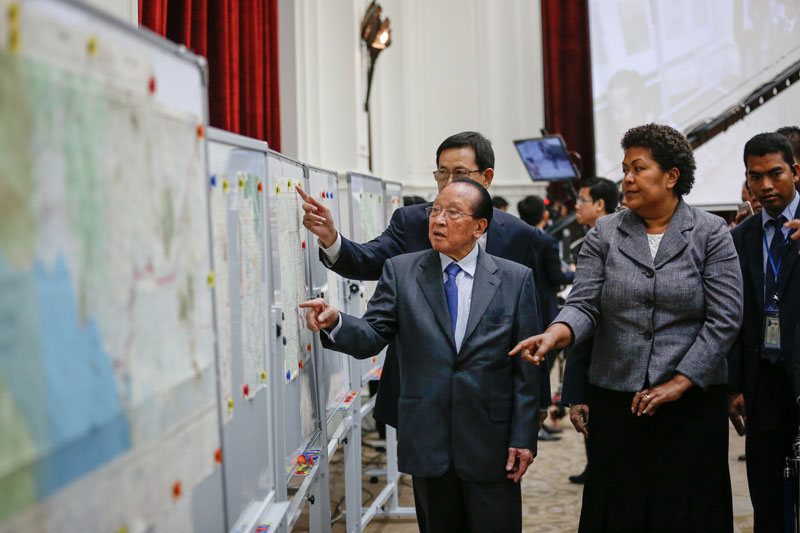The U.N. loaned maps of Cambodia’s border with Vietnam to the government Thursday, with Foreign Affairs Minister Hor Namhong hailing the maps’ similarity to the government’s own as proof that it has not been demarcating the border using illegal maps drawn by Vietnam.
Opposition CNRP lawmakers launched a campaign three months ago accusing the CPP government of complicity in Vietnamese incursions into Cambodian territory, calling for the official maps of the border to be released so they could verify if border posts have been planted in the correct places.

The government’s refusal to release the maps led some opposition lawmakers to accuse the ruling party of hiding its use of Vietnamese-drawn maps instead of using the colonial French-drawn maps mandated by the Constitution and deposited at the U.N.
Prime Minister Hun Sen subsequently asked the U.N. for its maps last month.
While the U.N. has said it could not find the exact maps required by the Constitution, which were drawn by the French between 1933 and 1953, Mereani Keleti Vakasisikakala, acting president of the U.N.’s Dag Hammarskjold Library, visited Mr. Hun Sen’s office building in Phnom Penh on Thursday to hand over the border maps that it did find.
“In accordance with this agreement between the United Nations and the government of Cambodia, we are here as the designated officials of the United Nations to hand over the maps to the government,” Ms. Vakasisikakala said.
“We wish to emphasize that the fact we are making available these maps to the government is not to be understood to imply any official endorsement or acceptance by the United Nations of the boundaries and names shown on them.”
The maps loaned by the U.N. are not part of the Bonne maps that were drawn by the French and deposited at the U.N. by Prince Norodom Sihanouk. Instead, they are similar maps drawn with the Universal Transverse Mercator (UTM) projection, which Council of Ministers spokesman Phay Siphan said were given to the U.N. during the U.S. bombings of Cambodia in the 1960s.
Despite this, Var Kimhong, the government’s minister in charge of border affairs, used the maps brought by the U.N. on Thursday to discredit the claims of some in the CNRP that the government has been using the wrong maps.
Mr. Kimhong laid tracing-paper copies of the government’s 1933-1953 Bonne maps on top of the U.N.’s UTM maps, which showed that the borderlines on both were almost identical in every segment.
Mr. Namhong, the foreign affairs minister, said that Mr. Kimhong’s presentation accordingly showed the CNRP’s folly.
“Our maps total 26 pieces but we have just brought 18 pieces in order to make it the same as the 18 map pieces from the U.N., and we can see that they are not different,” the foreign minister said.
The opposition’s campaign to discredit the government’s border work peaked on July 19 with CNRP lawmaker Real Camerin leading some 2,500 supporters to the Vietnamese border in Svay Rieng province, where soldiers, police and thugs with clubs prevented most of the group from inspecting a marker.
Two days later, 11 CNRP activists in a long-running “insurrection” trial were abruptly sentenced to between seven and 20 years in prison. Opposition leader Sam Rainsy said he interpreted the decision as a message to end the border campaign.
Mr. Rainsy finally called off the border campaign this week after opposition Senator Hong Sok Hour, one of the intellectual forces behind the campaign, was arrested on Mr. Hun Sen’s orders for presenting a doctored copy of a border treaty with Vietnam in a video posted on Facebook.
CNRP lawmaker Phirith Kimsour, who led the opposition’s delegation to Thursday’s ceremony, said after the event that the party would reserve judgment until the maps specified in the Constitution were produced by the U.N.
“The map from the U.N. is the UTM map and there are only 18 parts to that map and this map is not the map that Cambodia has provided to the U.N. in 1993. So the maps were similar, but we cannot yet say [the CPP’s] map is the real one or not,” he said.
“If we have the map from France [the Bonne map], and technical people, we can confirm if it is the real map or not.”
The opposition began lobbying the government to release its border maps so that CNRP activists can use them to check if border posts have been illegally placed inside Cambodia.
Mr. Kimsour said that was still the CNRP’s main concern, regardless of whether the government’s maps are found to be identical to those named in the Constitution.
However, CPP spokesman Sok Eysan said that the similarity of the government’s maps to the U.N.’s proved that the opposition has been leading a dishonest campaign.
“The verification of the maps today proves that the government’s maps used for the border between Cambodia and Vietnam are the right maps,” he said.
“And it is proof that a number of unfair politicians who always slander the government about fake maps have no more means to cheat people.”
(Additional reporting by Alex Willemyns)



